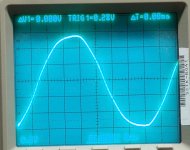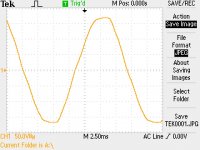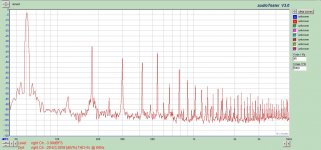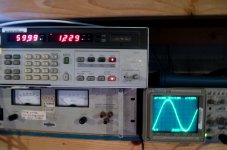Look on ebay and buy a 100x probe.
Do NOT use an unbalanced probe to measure the line. This is dangerous.
Transformers don't saturate with increased current demands <full stop> / the power companies don't operate their stuff close to saturation to ever be a worry esp. in hot areas.
The neighborhood I lived in in Florida was built in 1975. It was an older neighborhood with 7200 volt distribution. The distribution system was replaced after a hurricane ripped it up in 1999. Total distance from the substation is about 1 mile.
I moved in during 1978. We had a large steel cased pole transformer in the back yard with triplex from the pole with the transformer directly to the meter box, so the IR drop from the transformer to the house was minimal. There were 9 houses served from that transformer, 4 of us had triplex drops directly from the pole with the transformer, the rest were on longer runs. Our line voltage was pretty consistent, day to day, and within the day. I never measured the distortion, but the waveform looked pretty sinusoidal. My guess would be about 3%.
Somewhere in the early 2000's the odds ran out and some Florida lightning ate the transformer. The power company installed a new GE pole transformer. It clearly said "Made in China" on its plastic case. It was about half the size of the transformer it replaced. The line voltage as read on the smart meter face outside the house ranged from 236 to 248, but usually ran about 239 in the afternoon "power hour". The distortion at that time ran as high as 8.5%.
I took this picture during a measurement to verify the turns ratio of an unknown impedance OPT (good and big enough not to be an issue). I'm not sure what time of day it was, but I have seen better, and worse distortion.
Attachments
Somewhere in the early 2000's the odds ran out and some Florida lightning ate the transformer. The power company installed a new GE pole transformer. It clearly said "Made in China" on its plastic case. It was about half the size of the transformer it replaced.
yes the power company probably rightly down sized it due to lower consumption readings. This will make the V regulation you had run much worse and much more susceptible to the loading.
GE knows how to spec their gear not to saturate and balance core losses. I can say with confidence the distortion is from the load PF* and shrunken copper not the XFMR hitting the stops. load PF = capacitors charging at the peaks. E.g. typical consumer electronics and SMPS / PCs. it's sorta like they replaced the big block V8 and put in a smallish V6.
Last edited:
Somewhere in the early 2000's the odds ran out and some Florida lightning ate the transformer. The power company installed a new GE pole transformer. It clearly said "Made in China" on its plastic case. It was about half the size of the transformer it replaced.
I suspect you have two things going on. One, your primary voltage is beginning to distort as a result of increased odd harmonics being generated by electronic loads. Capacitance loaded rectifiers generate copious amounts, as a result of their peaked current draw at the voltage maximums. FFT attached shows this, from NC. It's pretty much all over the country. Getting better, actually, with the recent advent of active power factor correction (customer side) and inverter-based FACTS systems (utility side). On the secondary of the power transformer, the situation can only be worsened as a result of voltage drop.
Two, your transformer is almost certainly higher impedance than the former on a per unit basis. This amounts to poorer regulation. The latest "popcorn" off the shelf transformers run right at the cusp of saturation, unless they are energy star rated (not likely for utilities, where capital cost trumps efficiency).
GE knows how to spec their gear not to saturate and balance core losses.
The power industry opinion of GE is the acronym "Good Enough". They build a lower quality product than they used to, even with all the technology and FEA they have available to them. We daily maintain GE equipment from oil circuit breakers built in the 1920's to the latest MVA sized transformers out of Mexico. One who has experience in the product would easily prefer the old school GE over the latest garbage they are building. Medical equipment may be a different story, I wouldn't know.
Attachments
welcome to the modern world. wadda you gonna do, the bean counters have ruled we all cant drive around in big ole caddies and SUVs anymore.The power industry opinion of GE is the acronym "Good Enough". They build a lower quality product than they used to, even with all the technology and FEA they have available to them. We daily maintain GE equipment from oil circuit breakers built in the 1920's to the latest MVA sized transformers out of Mexico. One who has experience in the product would easily prefer the old school GE over the latest garbage they are building. Medical equipment may be a different story, I wouldn't know.
Last edited:
wow do I hear an echo in here,
core near saturation is worse at lightest loads so if the distortion is improving greatly with light loading it's certainly GE good enough.
Core saturation is dependent on primary excitation, which is unrelated to load. Utility primary (which is normally regulated with LTCs) will not change significantly with a residential transformer being loaded. So regardless of load core flux is the same.
The problem is not one of core saturation, it's voltage drop caused by high crest factor currents across the reactance of the transformer. Former transformer had lower reactance on a per unit basis. You can call it an echo, but I don't think you are actually listening.
The power industry opinion of GE is the acronym "Good Enough". They build a lower quality product than they used to, even with all the technology and FEA they have available to them. We daily maintain GE equipment from oil circuit breakers built in the 1920's to the latest MVA sized transformers out of Mexico. One who has experience in the product would easily prefer the old school GE over the latest garbage they are building. Medical equipment may be a different story, I wouldn't know.
Medical equipment is my primary business (support, repair, interfacing/networking). The equipment is still good, but the support and professionalism behind it is a different story. Relates much like the quality of the older equipment you mention above... I will say no more.
.................We had a large steel cased pole transformer in the back yard with triplex from the pole with the transformer directly to the meter box,....................
Somewhere in the early 2000's the odds ran out and some Florida lightning ate the transformer. The power company installed a new GE pole transformer. It clearly said "Made in China" on its plastic case. It was about half the size of the transformer it replaced. .................
Not here in Scotland.welcome to the modern world. wadda you gonna do, the bean counters have ruled we all cant drive around in big ole caddies and SUVs anymore.in the grand scheme of things for utility power, distortion is probably the last priority for residential consumers. right?
After I complained about one phase voltage being lower than the other two The distribution company came and measured the problem and eventually replaced the pole mounted transformer with one rated 4 times higher.
http://www.diyaudio.com/forums/ever...tage-scottish-power-response.html#post3724182
Scottish Power fitted a bigger 11000:400Vac transformer. Changed from 50kVA to 200kVA
Last edited:
Echo meaning you're just repeating my ideas right after I say it. adding excess fluff doesn't make it original bud.You can call it an echo, but I don't think you are actually listening.
I can say with confidence the distortion is from the load PF* and shrunken copper
Granted the picture shown looks a lot like all the diodes in all the houses refilling their associated reservoir caps at once. The "divot" in the sine wave comes as the peak voltage approaches.
I have seen the "divot in the side" type distortion characteristic of saturation on the Florida power lines, but I can't find it on my hard drive. One 50KVA pole transformer feeding 9 houses, each with electric stoves and central air conditioning is not enough.
I moved out of Florida about two years ago. I now live in rural West Virginia. We had a new house built and AEP replaced the pole and the transformer that serves our house. The new setup uses a 50KVA metal cased transformer, larger than the plastic unit in Florida, and serves two houses and two trailers. All are electric heated, but one trailer is unoccupied. It is currently 11 degrees outside, and everyone's heater is running, so I thought now would be a good time to scope my power. Looks good, measures 1.2% distortion.
Attachments
The power industry opinion of GE is the acronym "Good Enough". They build a lower quality product than they used to, even with all the technology and FEA they have available to them. We daily maintain GE equipment from oil circuit breakers built in the 1920's to the latest MVA sized transformers out of Mexico. One who has experience in the product would easily prefer the old school GE over the latest garbage they are building. Medical equipment may be a different story, I wouldn't know.
Last year I had to go up on the roof and see why an industrial A/C had lost efficiency. It was a motor-start cap. It was a GE cap and had been working for >20 years. I replaced it with an equivelent part cross-ref from the part number on the metal cap can. The replacement lasted about one year. This time I replaced the cap with one made by GE and with same p/n and same size and same oil type inside. No more problems so far and expect another 20+ years of service. The 'old' GE designs are still being made and are the best.
Over here in Calif/Nev, the Hoover hydro-dam has GE made HV transformers built in the 1930's and still working well. Those transformers power the whole west coast of USA.
THx-RNMarsh
All are electric heated, but one trailer is unoccupied. It is currently 11 degrees outside, and everyone's heater is running, so I thought now would be a good time to scope my power. Looks good, measures 1.2% distortion.
Hi Tubelab
sweet, a sinewave picture including a THD number, very nice > residential electric heat loading needs beefy support and the power factor is ideal. Have they got you on a 'smart meter' over there yet?
we have mostly all natural gas heat and cooking, but during the day the neighbors solar inverters kick onto the grid, so that would make some interesting high frequency reading I'm sure. Id say looking around, about 10% here have put solar on the rooftop within the past couple of years, luckily none on my distribution XFMR.
It was a motor-start cap. It was a GE cap and had been working for >20 years. I replaced it with an equivelent part cross-ref from the part number on the metal cap can. The replacement lasted about one year. This time I replaced the cap with one made by GE and with same p/n and same size and same oil type inside.
my GE branded garbage disposer (smallish China made) has been better in every aspect cost and performance than any 'merican' one by far.
We have smart meters that are accessed by radio, but unlike the smart meters in Florida, the display does not show anything useful, just accumulated KWH. The meter in Florida had an LCD that cycled through about 6 measurements.
Our house, and the house next door, have heat pumps. Both have smart controllers which will run the compressor based pump when there is sufficient heat energy outside to make it work. When it is too cold outside the system reverts to "auxiliary heat" which is basically a coat hanger plugged into the wall outlet. Aux has 1.00 PF. The motor has a "run" cap which creates a phase shift. I can't measure the PF on it, but it's probably close to 1 overall.
Today is has been switching back and forth. The sun shines on the outside unit, warming it, then the heat pump sucks all of that heat inside until there isn't enough to pump, and the system reverts to aux.
The guy in the trailer at the end of the lane had his outside unit covered for the winter, meaning his heat is purely resistive.
I installed LED lighting in by basement lab. I spent a day chasing down some funny "oscillation" in a guitar amp I'm building.....yeah, the Walmart LED shop light, which was off when I took that picture. I don't think it's bad enough to show up on the scope, but it cast a glare on the scope screen.
residential electric heat loading needs beefy support and the power factor is ideal
Our house, and the house next door, have heat pumps. Both have smart controllers which will run the compressor based pump when there is sufficient heat energy outside to make it work. When it is too cold outside the system reverts to "auxiliary heat" which is basically a coat hanger plugged into the wall outlet. Aux has 1.00 PF. The motor has a "run" cap which creates a phase shift. I can't measure the PF on it, but it's probably close to 1 overall.
Today is has been switching back and forth. The sun shines on the outside unit, warming it, then the heat pump sucks all of that heat inside until there isn't enough to pump, and the system reverts to aux.
The guy in the trailer at the end of the lane had his outside unit covered for the winter, meaning his heat is purely resistive.
solar inverters kick onto the grid, so that would make some interesting high frequency reading I'm sure.
I installed LED lighting in by basement lab. I spent a day chasing down some funny "oscillation" in a guitar amp I'm building.....yeah, the Walmart LED shop light, which was off when I took that picture. I don't think it's bad enough to show up on the scope, but it cast a glare on the scope screen.
I don't think it's bad enough to show up on the scope, but it cast a glare on the scope screen.
that's why I continue to like analog scopes real time wide BW, 'the glare' lets you know something else is there.
digital folks miss out esp when they probably don't know what theyre looking for>
Last edited:
"auxiliary heat" which is basically a coat hanger plugged into the wall outlet.
HA! HA! HA!
Another use for audiophile coat hangers other than speaker wiring!
'the glare' lets you know something else is there.
I was referring to the optical glare from the bare LED's about two feet above the scope. LED, or the old fluorescent, I always had to turn the bench lights off to photograph the scope.
digital folks miss out esp when they probably don't know what theyre looking for
That old TEK has an "analog" mode. It's still a sampling scope, so it can and does alias. I've seen these, and the early HP "Megazoom" scopes fool a lot of people at work.
I have three scopes, and I will keep an old true analog TEK around just in case I need a second opinion on something, but I have been using the TEK2232's since they came out. I know when to not trust them.
Another use for audiophile coat hangers other than speaker wiring
No good for speaker wires.....heaters don't use five nines coat hangers!
- Status
- This old topic is closed. If you want to reopen this topic, contact a moderator using the "Report Post" button.
- Home
- Design & Build
- Equipment & Tools
- How to measure 120V mains on an oscilloscope?



